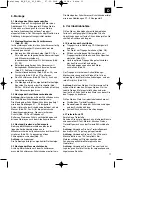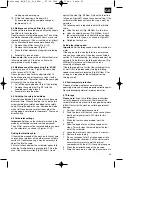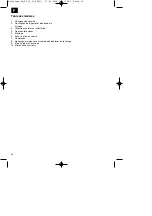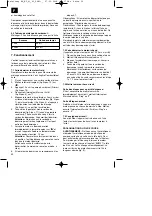
PLEASE NOTE:
Even if it is used carefully, cutting
around foundations, stone or concrete walls, etc. will
result in the line suffering more than normal wear.
TRIMMING / MOWING
Swing the trimmer from side to side in a scything
motion. Always keep the cutting head parallel to the
ground. Check the site and decide what cutting height
you require. Guide and hold the cutting head at the
required height to ensure that you cut evenly (Fig. I3).
LOWER TRIMMING
Hold the trimmer right in front of you at a slight angle
so that the underside of the cutter head is above the
ground and the line strikes the correct target. Always
cut away from yourself. Never draw the trimmer
towards yourself.
CUTTING ALONG FENCES / FOUNDATIONS
When cutting approach wire mesh fences, lath
fences, natural stone walls and foundations slowly so
that you can cut close to them without striking the
obstacle with the line. If, for example, the line strikes
stones, stone walls or foundations, it will wear or fray.
If the line strikes wire fencing it will break.
TRIMMING AROUND TREES
When trimming around tree trunks, approach slowly
so that the line does not strike the bark. Walk around
the tree, cutting from left to right. Approach grass or
weeds with the tip of the line and tilt the cutting head
forwards slightly.
WARNING:
Take extreme care during mowing work.
When doing such work keep a distance of 30 meters
between yourself and other people or animals.
MOWING
For mowing you want to cut all the vegetation down to
the ground. To do this, set the cutting head at an
angle of 30° to the right. Place the handle in the
required position. Remember the increased risk of
injury to the user, watchers and animals and the
danger of damaging other items due to objects (for
example stones) being thrown out (Fig. I4).
WARNING: Do not remove any objects from
footpaths, etc. using the trimmer.
The trimmer is a
powerful tool and can throw small stones and other
objects a distance of 15 meters or more, causing
injuries and damage to cars, houses and windows.
SAWING
The equipment is not suitable for sawing.
JAMMING
If the blade jams as a result of attempting to cut
vegetation that is too dense, switch off the motor
immediately.
Remove the grass and scrub from the equipment
before you restart it.
PREVENTING RECOIL
When you work with the blade there is a risk of recoil
if it strikes solid objects such as tree trunks,
branches, tree stumps, stones or the like. This will
throw the equipment backwards in the direction
opposite to the rotation of the tool.
This can cause you to lose control of the equipment.
Do not use the metal blade near fences, metal posts,
boundary stones or foundations.
For cutting dense stalks, position it as shown in Fig. I5
to prevent recoil.
8. Maintenance
Always switch off the machine and pull out the spark
boot plug before carrying out any maintenance work.
8.1 Replacing the line spool / cutting line
1.
Press the line spool housing together (Fig. L1)
below the two lugs (Fig. L2/Item 1) and remove
the line spool cover (Fig. L2/Item 2).
2.
Take the line spool out of the line spool housing
(Fig. L3). Make sure that you do not lose the
spring or the washers.
3.
Remove any remaining cutting line.
4.
Place the new cutting line in the center and attach
the resulting loop to the recess in the spool
splitter (Fig. L4)
5.
Wind the line on to the spool counter-clockwise
with tension. The spool splitter will separate the
two halves of the nylon line (Fig. L5)
6.
Hook the last 15 cm of the two ends of the line to
the line holders opposite the line spool (Fig. L6)
7.
Thread the two ends of the line through the metal
eyelets in the line spool housing (Fig. L3).
8.
Press the line spool into the line spool housing.
Ensure that the spring and washers are in the
correct position (Fig. L3)
9.
Press the line spool cover on to the line spool
housing. Ensure that the two lugs (Fig. L2/Item 1)
in the line spool housing lock into the appropriate
recesses (Fig. L2/Item 2) in the line spool cover.
10.
Pull the two line ends briefly and powerfully to
release them from the line holders in the line
spool.
11.
Cut the excess line to a length of around 13 cm.
This will reduce the load on the engine when
22
GB
Anleitung BG_BC_41_43_SPK1:_ 07.03.2008 10:17 Uhr Seite 22
Содержание 34.017.40
Страница 5: ...5 F7 F9 F8 G1 G3 G2 G4 G6 G5 H I2 I1 Anleitung BG_BC_41_43_SPK1 _ 07 03 2008 10 16 Uhr Seite 5...
Страница 6: ...6 I3 I5 I4 J1 J3 J2 K1 L1 K2 L2 L4 L3 2 1 Anleitung BG_BC_41_43_SPK1 _ 07 03 2008 10 16 Uhr Seite 6...
Страница 7: ...7 L5 M1 L6 M2 M4 M3 4 3 5 1 2 Anleitung BG_BC_41_43_SPK1 _ 07 03 2008 10 16 Uhr Seite 7...
Страница 93: ...93 Anleitung BG_BC_41_43_SPK1 _ 07 03 2008 10 17 Uhr Seite 93...
Страница 94: ...94 Anleitung BG_BC_41_43_SPK1 _ 07 03 2008 10 17 Uhr Seite 94...
















































